Management Accounting Report: Budgetary Control and Financial Problems
VerifiedAdded on 2020/12/09
|8
|1601
|50
Report
AI Summary
This report delves into the application of management accounting techniques and planning tools for effective budgetary control and financial sustainability. It explores various budgeting methods such as activity-based, zero-based, and incremental budgeting, analyzing their merits and demerits. The report also examines the use of planning tools like Net Present Value (NPV) and Internal Rate of Return (IRR) in operational contexts. Furthermore, it highlights how management accounting techniques, including Key Performance Indicators (KPIs), financial governance, balanced scorecards, and variance analysis, are crucial for resolving financial problems and ensuring long-term financial health. The conclusion emphasizes the significance of controlling financial transactions and promoting performance efficiency through management accounting practices.
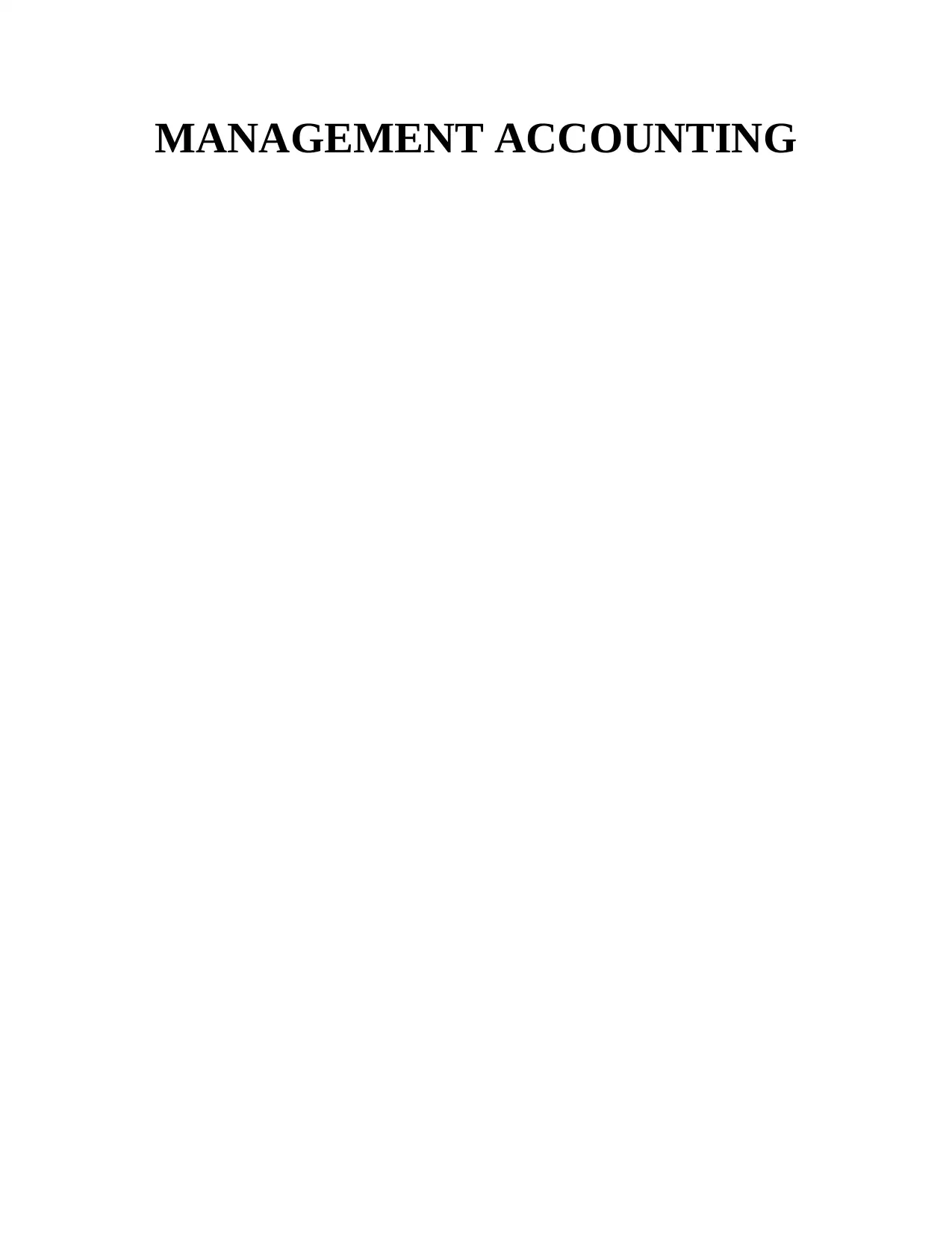
MANAGEMENT ACCOUNTING
Paraphrase This Document
Need a fresh take? Get an instant paraphrase of this document with our AI Paraphraser
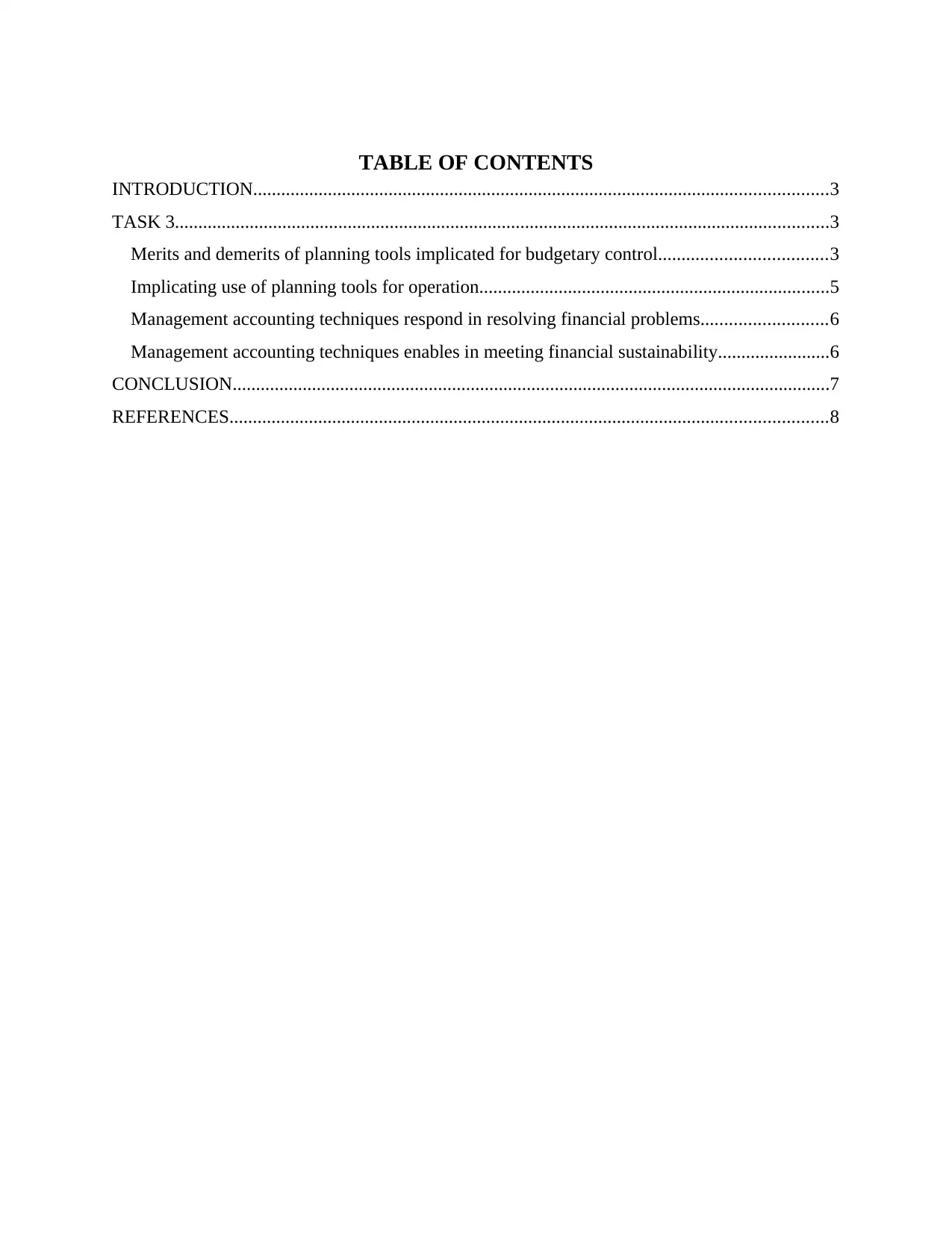
TABLE OF CONTENTS
INTRODUCTION...........................................................................................................................3
TASK 3............................................................................................................................................3
Merits and demerits of planning tools implicated for budgetary control....................................3
Implicating use of planning tools for operation...........................................................................5
Management accounting techniques respond in resolving financial problems...........................6
Management accounting techniques enables in meeting financial sustainability........................6
CONCLUSION................................................................................................................................7
REFERENCES................................................................................................................................8
INTRODUCTION...........................................................................................................................3
TASK 3............................................................................................................................................3
Merits and demerits of planning tools implicated for budgetary control....................................3
Implicating use of planning tools for operation...........................................................................5
Management accounting techniques respond in resolving financial problems...........................6
Management accounting techniques enables in meeting financial sustainability........................6
CONCLUSION................................................................................................................................7
REFERENCES................................................................................................................................8
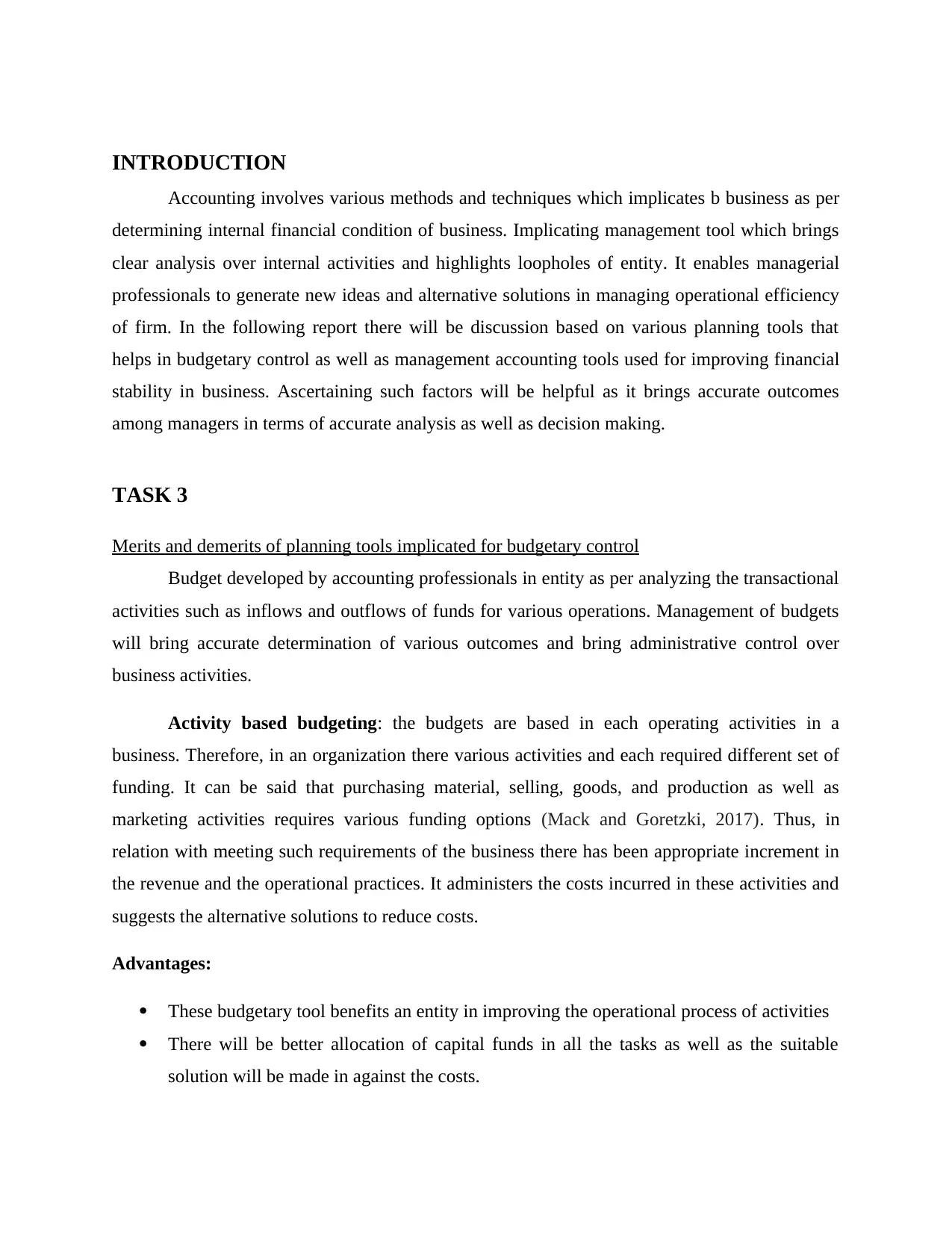
INTRODUCTION
Accounting involves various methods and techniques which implicates b business as per
determining internal financial condition of business. Implicating management tool which brings
clear analysis over internal activities and highlights loopholes of entity. It enables managerial
professionals to generate new ideas and alternative solutions in managing operational efficiency
of firm. In the following report there will be discussion based on various planning tools that
helps in budgetary control as well as management accounting tools used for improving financial
stability in business. Ascertaining such factors will be helpful as it brings accurate outcomes
among managers in terms of accurate analysis as well as decision making.
TASK 3
Merits and demerits of planning tools implicated for budgetary control
Budget developed by accounting professionals in entity as per analyzing the transactional
activities such as inflows and outflows of funds for various operations. Management of budgets
will bring accurate determination of various outcomes and bring administrative control over
business activities.
Activity based budgeting: the budgets are based in each operating activities in a
business. Therefore, in an organization there various activities and each required different set of
funding. It can be said that purchasing material, selling, goods, and production as well as
marketing activities requires various funding options (Mack and Goretzki, 2017). Thus, in
relation with meeting such requirements of the business there has been appropriate increment in
the revenue and the operational practices. It administers the costs incurred in these activities and
suggests the alternative solutions to reduce costs.
Advantages:
These budgetary tool benefits an entity in improving the operational process of activities
There will be better allocation of capital funds in all the tasks as well as the suitable
solution will be made in against the costs.
Accounting involves various methods and techniques which implicates b business as per
determining internal financial condition of business. Implicating management tool which brings
clear analysis over internal activities and highlights loopholes of entity. It enables managerial
professionals to generate new ideas and alternative solutions in managing operational efficiency
of firm. In the following report there will be discussion based on various planning tools that
helps in budgetary control as well as management accounting tools used for improving financial
stability in business. Ascertaining such factors will be helpful as it brings accurate outcomes
among managers in terms of accurate analysis as well as decision making.
TASK 3
Merits and demerits of planning tools implicated for budgetary control
Budget developed by accounting professionals in entity as per analyzing the transactional
activities such as inflows and outflows of funds for various operations. Management of budgets
will bring accurate determination of various outcomes and bring administrative control over
business activities.
Activity based budgeting: the budgets are based in each operating activities in a
business. Therefore, in an organization there various activities and each required different set of
funding. It can be said that purchasing material, selling, goods, and production as well as
marketing activities requires various funding options (Mack and Goretzki, 2017). Thus, in
relation with meeting such requirements of the business there has been appropriate increment in
the revenue and the operational practices. It administers the costs incurred in these activities and
suggests the alternative solutions to reduce costs.
Advantages:
These budgetary tool benefits an entity in improving the operational process of activities
There will be better allocation of capital funds in all the tasks as well as the suitable
solution will be made in against the costs.
⊘ This is a preview!⊘
Do you want full access?
Subscribe today to unlock all pages.

Trusted by 1+ million students worldwide
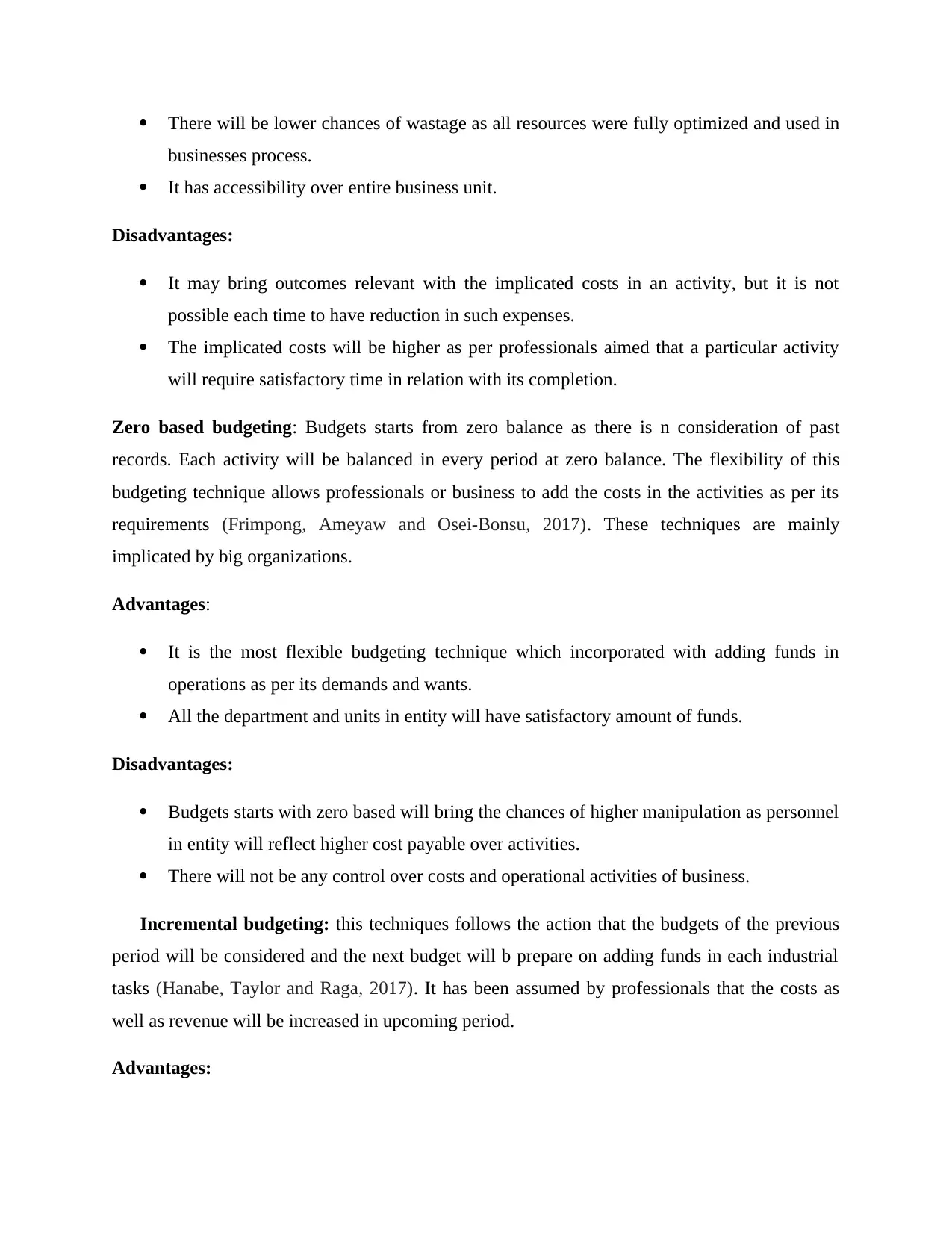
There will be lower chances of wastage as all resources were fully optimized and used in
businesses process.
It has accessibility over entire business unit.
Disadvantages:
It may bring outcomes relevant with the implicated costs in an activity, but it is not
possible each time to have reduction in such expenses.
The implicated costs will be higher as per professionals aimed that a particular activity
will require satisfactory time in relation with its completion.
Zero based budgeting: Budgets starts from zero balance as there is n consideration of past
records. Each activity will be balanced in every period at zero balance. The flexibility of this
budgeting technique allows professionals or business to add the costs in the activities as per its
requirements (Frimpong, Ameyaw and Osei-Bonsu, 2017). These techniques are mainly
implicated by big organizations.
Advantages:
It is the most flexible budgeting technique which incorporated with adding funds in
operations as per its demands and wants.
All the department and units in entity will have satisfactory amount of funds.
Disadvantages:
Budgets starts with zero based will bring the chances of higher manipulation as personnel
in entity will reflect higher cost payable over activities.
There will not be any control over costs and operational activities of business.
Incremental budgeting: this techniques follows the action that the budgets of the previous
period will be considered and the next budget will b prepare on adding funds in each industrial
tasks (Hanabe, Taylor and Raga, 2017). It has been assumed by professionals that the costs as
well as revenue will be increased in upcoming period.
Advantages:
businesses process.
It has accessibility over entire business unit.
Disadvantages:
It may bring outcomes relevant with the implicated costs in an activity, but it is not
possible each time to have reduction in such expenses.
The implicated costs will be higher as per professionals aimed that a particular activity
will require satisfactory time in relation with its completion.
Zero based budgeting: Budgets starts from zero balance as there is n consideration of past
records. Each activity will be balanced in every period at zero balance. The flexibility of this
budgeting technique allows professionals or business to add the costs in the activities as per its
requirements (Frimpong, Ameyaw and Osei-Bonsu, 2017). These techniques are mainly
implicated by big organizations.
Advantages:
It is the most flexible budgeting technique which incorporated with adding funds in
operations as per its demands and wants.
All the department and units in entity will have satisfactory amount of funds.
Disadvantages:
Budgets starts with zero based will bring the chances of higher manipulation as personnel
in entity will reflect higher cost payable over activities.
There will not be any control over costs and operational activities of business.
Incremental budgeting: this techniques follows the action that the budgets of the previous
period will be considered and the next budget will b prepare on adding funds in each industrial
tasks (Hanabe, Taylor and Raga, 2017). It has been assumed by professionals that the costs as
well as revenue will be increased in upcoming period.
Advantages:
Paraphrase This Document
Need a fresh take? Get an instant paraphrase of this document with our AI Paraphraser
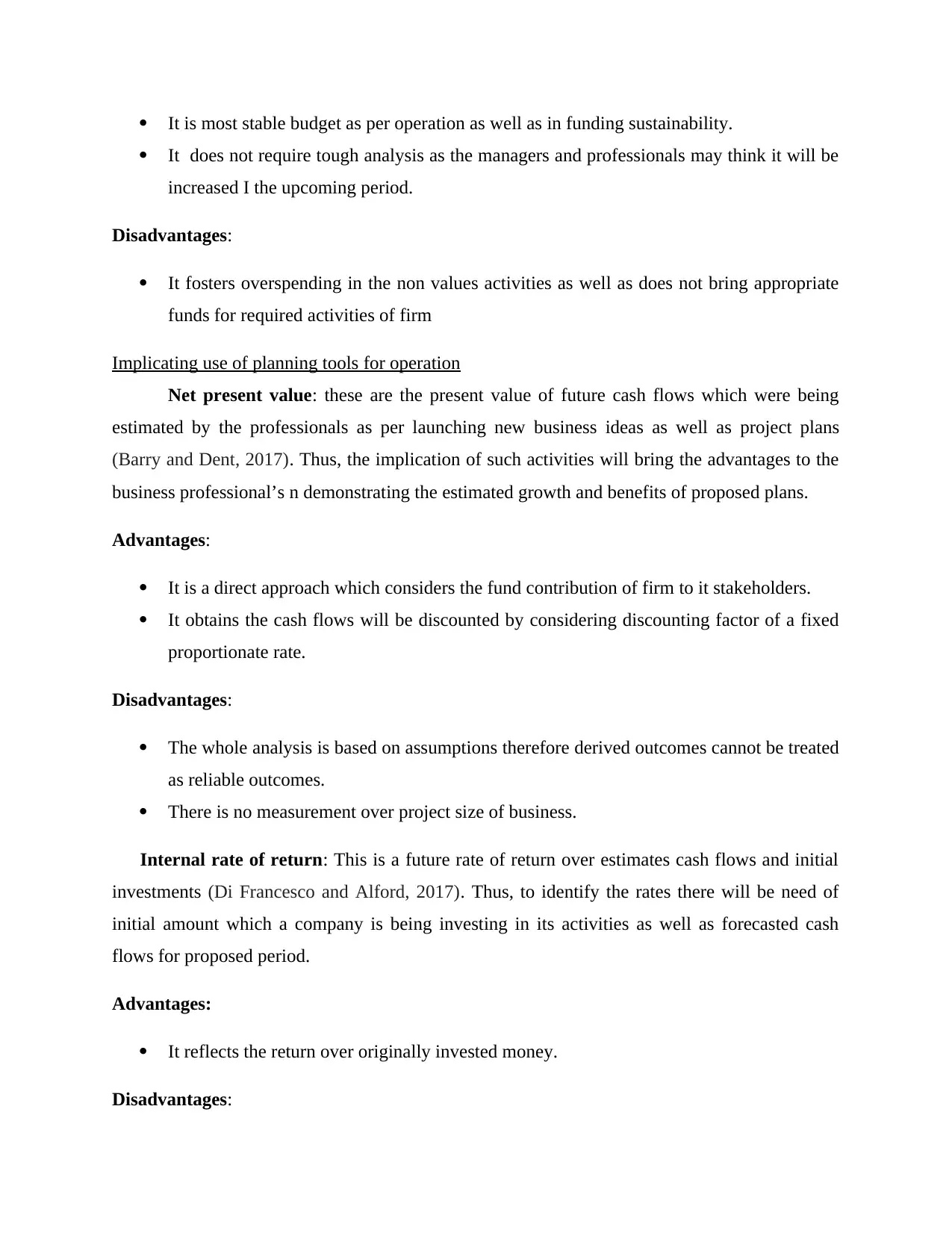
It is most stable budget as per operation as well as in funding sustainability.
It does not require tough analysis as the managers and professionals may think it will be
increased I the upcoming period.
Disadvantages:
It fosters overspending in the non values activities as well as does not bring appropriate
funds for required activities of firm
Implicating use of planning tools for operation
Net present value: these are the present value of future cash flows which were being
estimated by the professionals as per launching new business ideas as well as project plans
(Barry and Dent, 2017). Thus, the implication of such activities will bring the advantages to the
business professional’s n demonstrating the estimated growth and benefits of proposed plans.
Advantages:
It is a direct approach which considers the fund contribution of firm to it stakeholders.
It obtains the cash flows will be discounted by considering discounting factor of a fixed
proportionate rate.
Disadvantages:
The whole analysis is based on assumptions therefore derived outcomes cannot be treated
as reliable outcomes.
There is no measurement over project size of business.
Internal rate of return: This is a future rate of return over estimates cash flows and initial
investments (Di Francesco and Alford, 2017). Thus, to identify the rates there will be need of
initial amount which a company is being investing in its activities as well as forecasted cash
flows for proposed period.
Advantages:
It reflects the return over originally invested money.
Disadvantages:
It does not require tough analysis as the managers and professionals may think it will be
increased I the upcoming period.
Disadvantages:
It fosters overspending in the non values activities as well as does not bring appropriate
funds for required activities of firm
Implicating use of planning tools for operation
Net present value: these are the present value of future cash flows which were being
estimated by the professionals as per launching new business ideas as well as project plans
(Barry and Dent, 2017). Thus, the implication of such activities will bring the advantages to the
business professional’s n demonstrating the estimated growth and benefits of proposed plans.
Advantages:
It is a direct approach which considers the fund contribution of firm to it stakeholders.
It obtains the cash flows will be discounted by considering discounting factor of a fixed
proportionate rate.
Disadvantages:
The whole analysis is based on assumptions therefore derived outcomes cannot be treated
as reliable outcomes.
There is no measurement over project size of business.
Internal rate of return: This is a future rate of return over estimates cash flows and initial
investments (Di Francesco and Alford, 2017). Thus, to identify the rates there will be need of
initial amount which a company is being investing in its activities as well as forecasted cash
flows for proposed period.
Advantages:
It reflects the return over originally invested money.
Disadvantages:
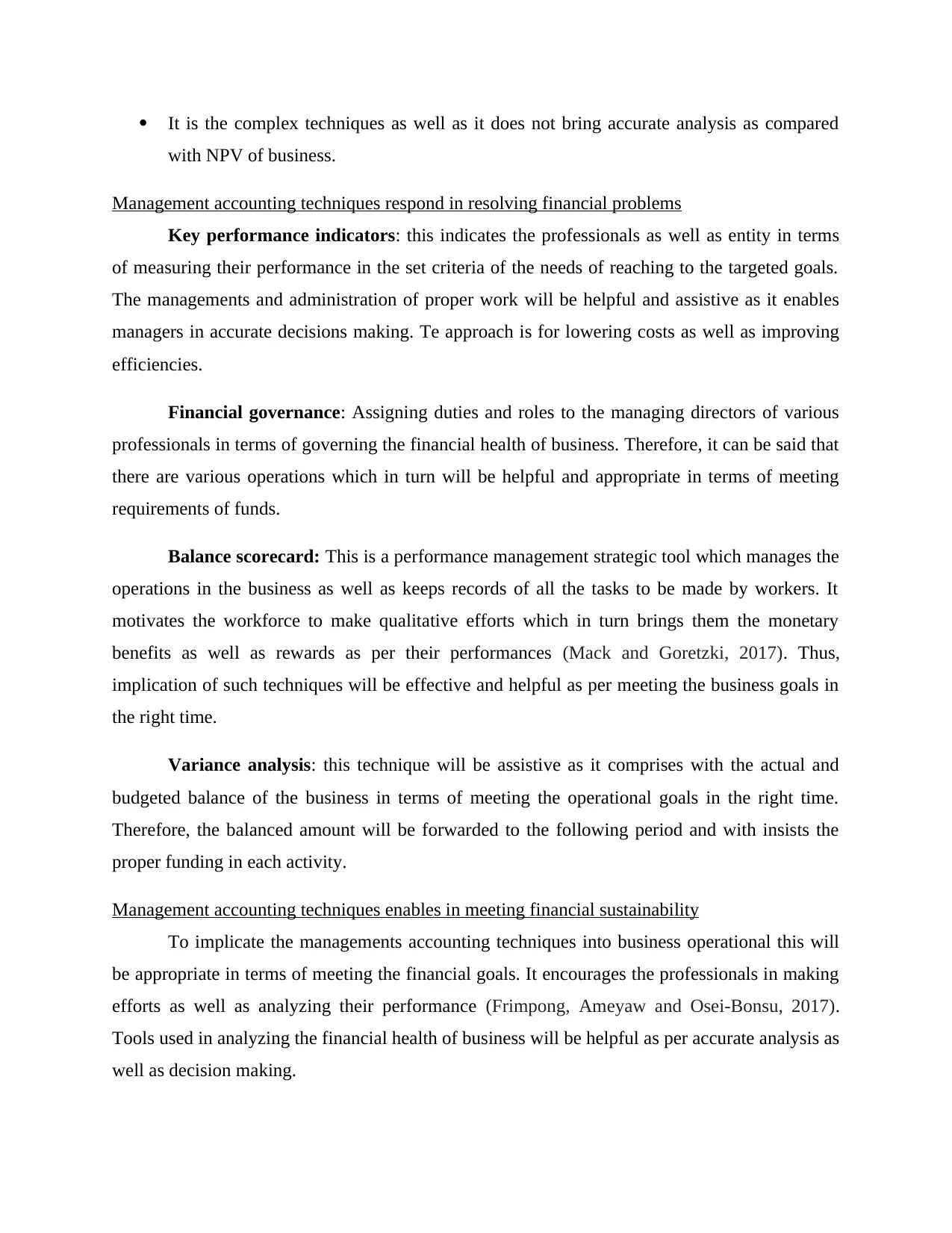
It is the complex techniques as well as it does not bring accurate analysis as compared
with NPV of business.
Management accounting techniques respond in resolving financial problems
Key performance indicators: this indicates the professionals as well as entity in terms
of measuring their performance in the set criteria of the needs of reaching to the targeted goals.
The managements and administration of proper work will be helpful and assistive as it enables
managers in accurate decisions making. Te approach is for lowering costs as well as improving
efficiencies.
Financial governance: Assigning duties and roles to the managing directors of various
professionals in terms of governing the financial health of business. Therefore, it can be said that
there are various operations which in turn will be helpful and appropriate in terms of meeting
requirements of funds.
Balance scorecard: This is a performance management strategic tool which manages the
operations in the business as well as keeps records of all the tasks to be made by workers. It
motivates the workforce to make qualitative efforts which in turn brings them the monetary
benefits as well as rewards as per their performances (Mack and Goretzki, 2017). Thus,
implication of such techniques will be effective and helpful as per meeting the business goals in
the right time.
Variance analysis: this technique will be assistive as it comprises with the actual and
budgeted balance of the business in terms of meeting the operational goals in the right time.
Therefore, the balanced amount will be forwarded to the following period and with insists the
proper funding in each activity.
Management accounting techniques enables in meeting financial sustainability
To implicate the managements accounting techniques into business operational this will
be appropriate in terms of meeting the financial goals. It encourages the professionals in making
efforts as well as analyzing their performance (Frimpong, Ameyaw and Osei-Bonsu, 2017).
Tools used in analyzing the financial health of business will be helpful as per accurate analysis as
well as decision making.
with NPV of business.
Management accounting techniques respond in resolving financial problems
Key performance indicators: this indicates the professionals as well as entity in terms
of measuring their performance in the set criteria of the needs of reaching to the targeted goals.
The managements and administration of proper work will be helpful and assistive as it enables
managers in accurate decisions making. Te approach is for lowering costs as well as improving
efficiencies.
Financial governance: Assigning duties and roles to the managing directors of various
professionals in terms of governing the financial health of business. Therefore, it can be said that
there are various operations which in turn will be helpful and appropriate in terms of meeting
requirements of funds.
Balance scorecard: This is a performance management strategic tool which manages the
operations in the business as well as keeps records of all the tasks to be made by workers. It
motivates the workforce to make qualitative efforts which in turn brings them the monetary
benefits as well as rewards as per their performances (Mack and Goretzki, 2017). Thus,
implication of such techniques will be effective and helpful as per meeting the business goals in
the right time.
Variance analysis: this technique will be assistive as it comprises with the actual and
budgeted balance of the business in terms of meeting the operational goals in the right time.
Therefore, the balanced amount will be forwarded to the following period and with insists the
proper funding in each activity.
Management accounting techniques enables in meeting financial sustainability
To implicate the managements accounting techniques into business operational this will
be appropriate in terms of meeting the financial goals. It encourages the professionals in making
efforts as well as analyzing their performance (Frimpong, Ameyaw and Osei-Bonsu, 2017).
Tools used in analyzing the financial health of business will be helpful as per accurate analysis as
well as decision making.
⊘ This is a preview!⊘
Do you want full access?
Subscribe today to unlock all pages.

Trusted by 1+ million students worldwide
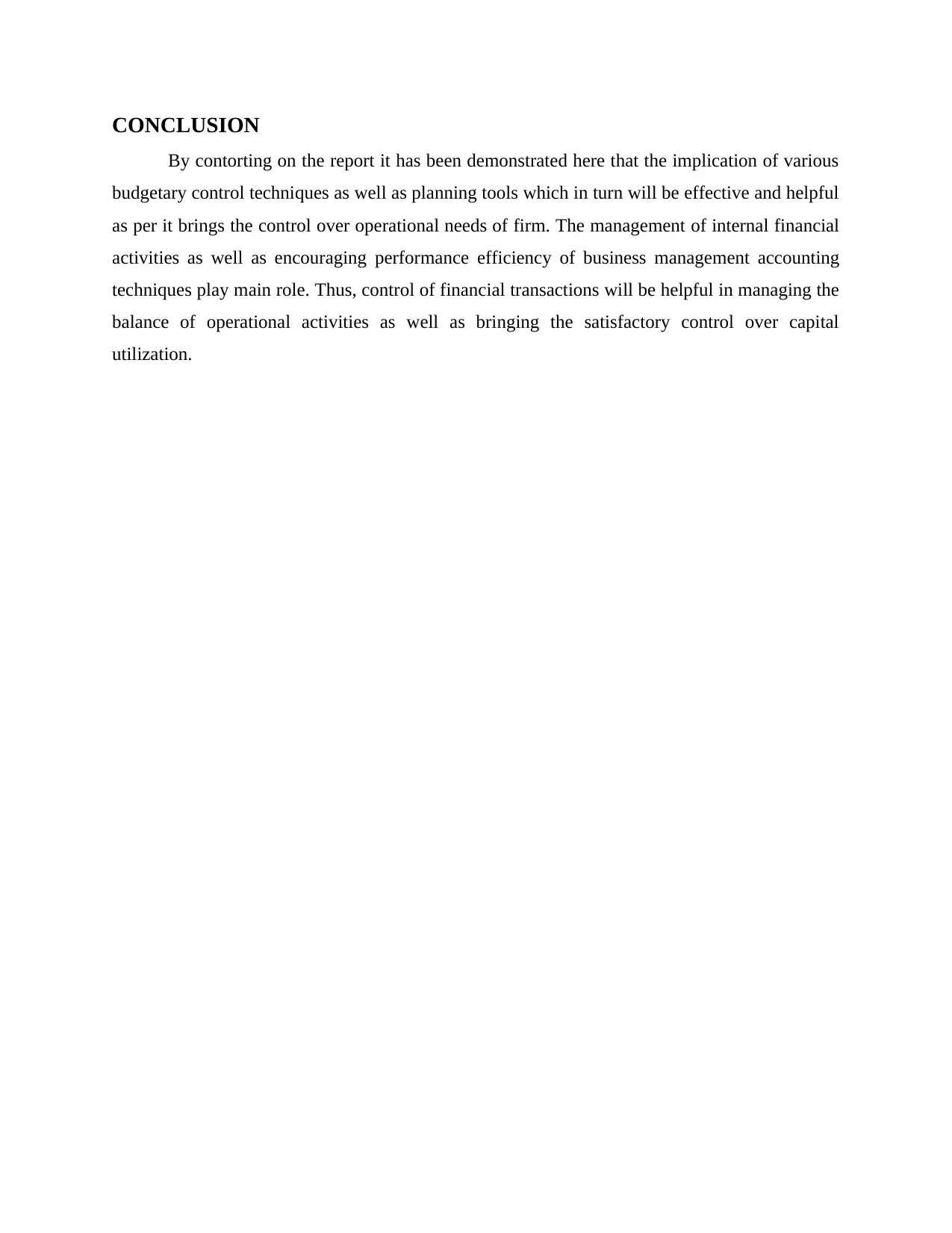
CONCLUSION
By contorting on the report it has been demonstrated here that the implication of various
budgetary control techniques as well as planning tools which in turn will be effective and helpful
as per it brings the control over operational needs of firm. The management of internal financial
activities as well as encouraging performance efficiency of business management accounting
techniques play main role. Thus, control of financial transactions will be helpful in managing the
balance of operational activities as well as bringing the satisfactory control over capital
utilization.
By contorting on the report it has been demonstrated here that the implication of various
budgetary control techniques as well as planning tools which in turn will be effective and helpful
as per it brings the control over operational needs of firm. The management of internal financial
activities as well as encouraging performance efficiency of business management accounting
techniques play main role. Thus, control of financial transactions will be helpful in managing the
balance of operational activities as well as bringing the satisfactory control over capital
utilization.
Paraphrase This Document
Need a fresh take? Get an instant paraphrase of this document with our AI Paraphraser
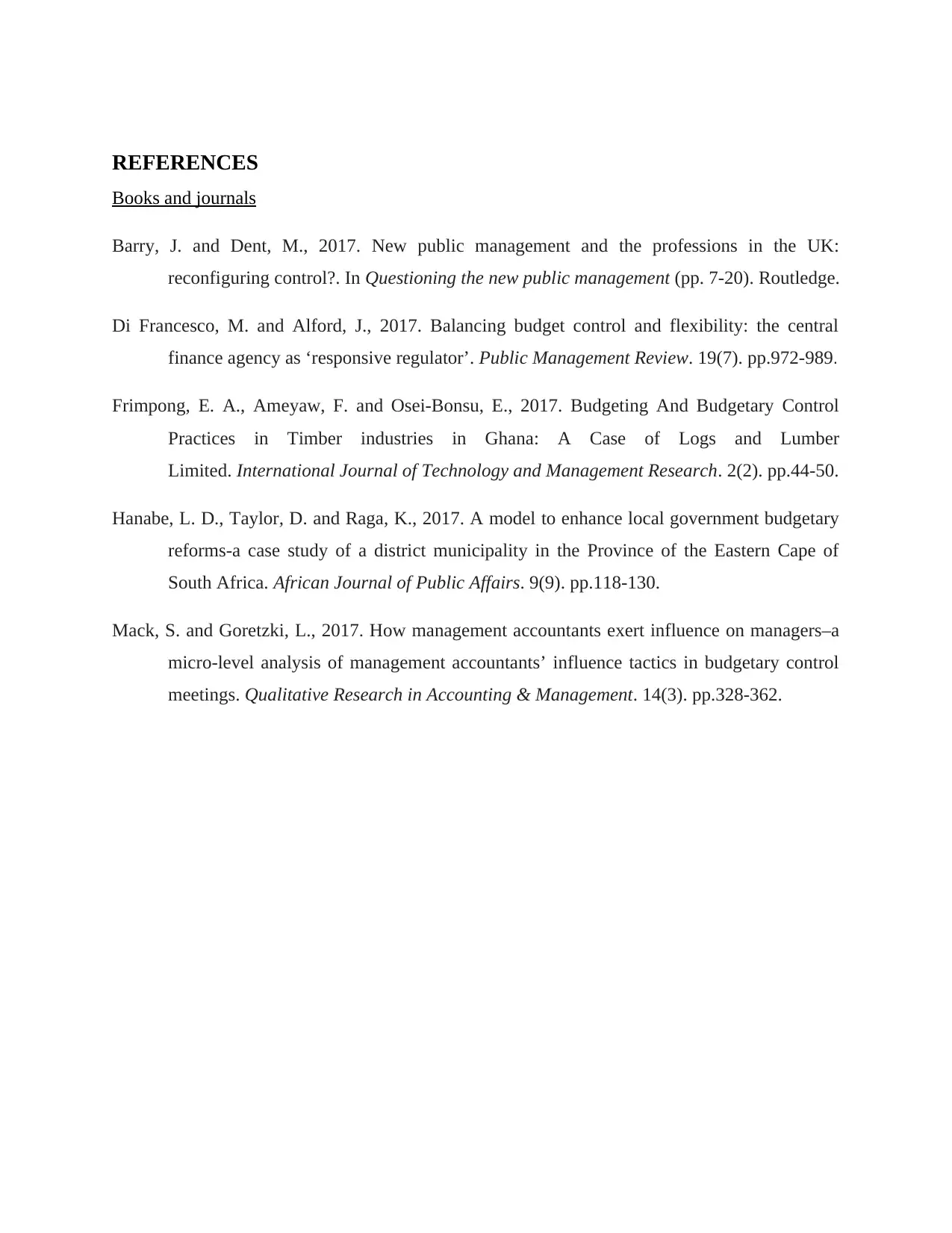
REFERENCES
Books and journals
Barry, J. and Dent, M., 2017. New public management and the professions in the UK:
reconfiguring control?. In Questioning the new public management (pp. 7-20). Routledge.
Di Francesco, M. and Alford, J., 2017. Balancing budget control and flexibility: the central
finance agency as ‘responsive regulator’. Public Management Review. 19(7). pp.972-989.
Frimpong, E. A., Ameyaw, F. and Osei-Bonsu, E., 2017. Budgeting And Budgetary Control
Practices in Timber industries in Ghana: A Case of Logs and Lumber
Limited. International Journal of Technology and Management Research. 2(2). pp.44-50.
Hanabe, L. D., Taylor, D. and Raga, K., 2017. A model to enhance local government budgetary
reforms-a case study of a district municipality in the Province of the Eastern Cape of
South Africa. African Journal of Public Affairs. 9(9). pp.118-130.
Mack, S. and Goretzki, L., 2017. How management accountants exert influence on managers–a
micro-level analysis of management accountants’ influence tactics in budgetary control
meetings. Qualitative Research in Accounting & Management. 14(3). pp.328-362.
Books and journals
Barry, J. and Dent, M., 2017. New public management and the professions in the UK:
reconfiguring control?. In Questioning the new public management (pp. 7-20). Routledge.
Di Francesco, M. and Alford, J., 2017. Balancing budget control and flexibility: the central
finance agency as ‘responsive regulator’. Public Management Review. 19(7). pp.972-989.
Frimpong, E. A., Ameyaw, F. and Osei-Bonsu, E., 2017. Budgeting And Budgetary Control
Practices in Timber industries in Ghana: A Case of Logs and Lumber
Limited. International Journal of Technology and Management Research. 2(2). pp.44-50.
Hanabe, L. D., Taylor, D. and Raga, K., 2017. A model to enhance local government budgetary
reforms-a case study of a district municipality in the Province of the Eastern Cape of
South Africa. African Journal of Public Affairs. 9(9). pp.118-130.
Mack, S. and Goretzki, L., 2017. How management accountants exert influence on managers–a
micro-level analysis of management accountants’ influence tactics in budgetary control
meetings. Qualitative Research in Accounting & Management. 14(3). pp.328-362.
1 out of 8
Related Documents
Your All-in-One AI-Powered Toolkit for Academic Success.
+13062052269
info@desklib.com
Available 24*7 on WhatsApp / Email
![[object Object]](/_next/static/media/star-bottom.7253800d.svg)
Unlock your academic potential
Copyright © 2020–2025 A2Z Services. All Rights Reserved. Developed and managed by ZUCOL.




